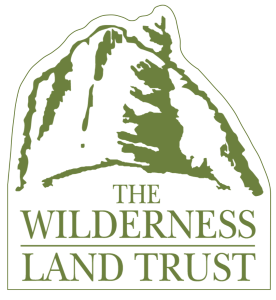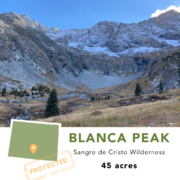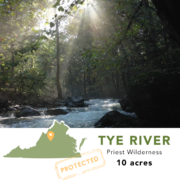Last threat of development removed from the sacred Blanca Peak
January 26, 2024-
The Wilderness Land Trust recently accepted a donation of 45 acres on the slopes of Blanca Peak, removing the last private property from the peak.
Blanca Peak stands at over 14,300 feet just outside of the Sangre de Cristo Wilderness in southern Colorado. But the peak is also known by another name, one that predates the Spanish descriptor of its near-vertical white slopes by centuries.
 For the Dinè, or Navajo, the peak is Sisnaajiní. It is one of the four corners marking the boundary of the Dinetah, the traditional Dinè homeland, along with three other sacred mountains— Dibé Nitsaa in the north (Hesperus Mountain in the La Plata Mountain range of Colorado), Doko’o’osliid in the west (Humphrey Peak in the San Francisco Peaks of Northern Arizona), and Tsoodzil in the south (Mt. Taylor Peak, west of Albuquerque, New Mexico).
For the Dinè, or Navajo, the peak is Sisnaajiní. It is one of the four corners marking the boundary of the Dinetah, the traditional Dinè homeland, along with three other sacred mountains— Dibé Nitsaa in the north (Hesperus Mountain in the La Plata Mountain range of Colorado), Doko’o’osliid in the west (Humphrey Peak in the San Francisco Peaks of Northern Arizona), and Tsoodzil in the south (Mt. Taylor Peak, west of Albuquerque, New Mexico).
More than just a location marker, Sisnaajiní is known as an internal compass, orienting one’s mind and physical presence on earth. Like the sun rising in the east, Sisnaajiní represents thought, the place where each day, and each action, begins. It was a gift from the Holy People to the Dinè: “When the Holy People had assembled the things with which to dress the East mountain, they traveled by way of a sunbeam and rainbow beam to decorate Sisnaajiní. The Holy People dressed Sisnaajiní with a perfect white shell for positive thoughts and thinking. Then the Holy People ran a bolt of lighting through a sacred mountain to fasten the East mountain to our Mother Earth.” (Navajopeople.org)
Beginning in the 1890s the slopes of Blanca Peak were mined for silver and gold, the mining claims eventually leading to a number of private inholdings surrounded by National Forest, some with a road leading to them. When the Sangre de Cristo Wilderness was designated in 1993, a strip of land along the Huerfano River where the access road runs, was excluded from the wilderness area, cutting it in two.

While hiking into the nearby Lily Lake for a fishing trip in the early 2000s, David Carrick of Boulder, CO fell in love with the area, and after discovering how many private properties were still spread throughout it, he began buying them. Inspired by his love for public lands, David had a company helping to facilitate land transfers, and through one was able to transfer all but six of the private properties on Blanca Peak to public ownership. With a road leading to them, the remaining properties had a high risk of development, and David was approached with interest to buy them and develop them with cabins. But David, and his wife Pamela, chose a different path. Instead they donated the remaining six Blanca Peak properties to The Wilderness Land Trust. “I wasn’t familiar with the Trust previously, but as I started looking into them and understanding how they work, we felt confident that if we handed the properties over to them, they would be able to hold them until they could become public lands, which is what we wanted to see,” says David.
Thanks to the generosity of David and Pamela, and their commitment to seeing the landscape around Blanca Peak unified as public lands, the Trust has now begun the work of transferring the properties to the National Forest. With it no longer providing access to the private properties, the hope is that the road running along the Huerfano River can be converted to a trail, and someday the fracture through the wilderness area can be closed. With the last private properties removed, this sacred mountain is protected, ensuring it is open for future generations of Dinè for cultural and spiritual practices, as well as future generations of mountaineers inspired by its challenging climb.



